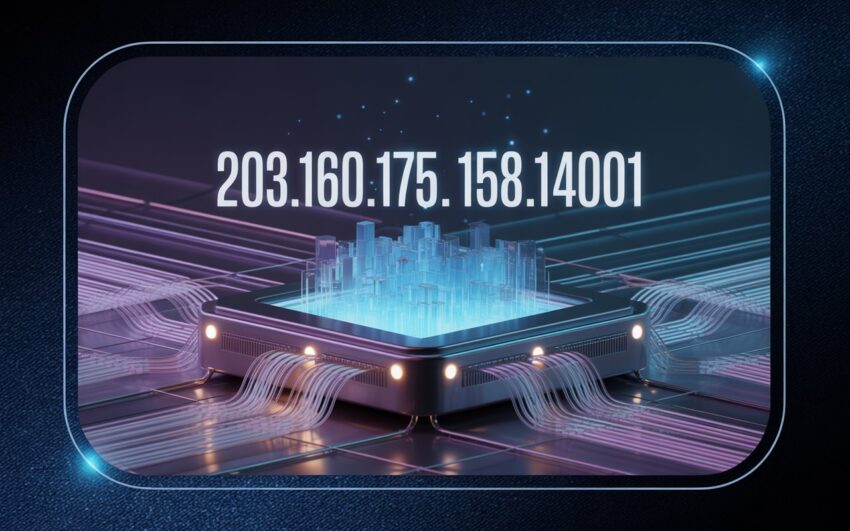Introduction
Every device connected to the internet needs a unique identifier, and that’s where IP addresses and ports come in. One such example is 203.160.175.158.14001, which combines both an IP address and a port number. While at first it may look like a random sequence of numbers, it actually represents a structured way of allowing devices to communicate securely and efficiently across networks.
In this article, we’ll break down the meaning of 203.160.175.158.14001, explore its importance in networking, discuss strategies for managing and securing such addresses, and highlight future trends in internet infrastructure. Whether you’re an IT professional, a business owner, or a curious reader, understanding identifiers like 203.160.175.158.14001 is essential in today’s digital age.
What is 203.160.175.158.14001?
The sequence 203.160.175.158.14001 can be split into two parts:
-
203.160.175.158 – This is an IPv4 address, a unique identifier that tells computers where to send and receive data.
-
14001 – This is a port number, which designates a specific service or process on a device.
Together, they form a combination that allows applications to communicate effectively. For instance, while the IP address points to the device, the port number ensures the data goes to the correct application (like a web server, mail service, or database).
-
IPv4 format: Uses four sets of numbers ranging from 0–255.
-
Port numbers: Range from 0–65535, with common ports like 80 (HTTP), 443 (HTTPS), and 25 (SMTP).
Thus, 203.160.175.158.14001 essentially tells us: “Send this data to the device at IP 203.160.175.158, specifically to the service listening on port 14001.”
Why 203.160.175.158.14001 Matters
Understanding addresses like 203.160.175.158.14001 is important for several reasons:
-
Efficient Communication – IPs ensure that data finds the right machine, while ports ensure it reaches the right service.
-
Security Awareness – Misconfigured ports are often targets for cyberattacks.
-
Network Management – IT administrators rely on IP-port combinations to manage traffic.
-
Troubleshooting – When connections fail, IP addresses and port numbers are the first things to check.
-
Scalability – Large businesses need thousands of such identifiers to manage cloud services and databases.
Without addresses like 203.160.175.158.14001, the internet would be a chaotic space with no organized way to deliver data.
Benefits of Using Structured IP-Port Combinations
Whether you’re a business or an individual, there are direct benefits to understanding and managing addresses like 203.160.175.158.14001.
For Individuals
-
Better control over home networks.
-
Ability to configure remote access safely.
-
Awareness of risks when using open ports.
For Businesses
-
Improved data security through proper port management.
-
Better resource allocation by assigning specific ports to services.
-
Enhanced monitoring and logging for suspicious activities tied to IP-port combinations.
For Developers
-
Cleaner application deployment.
-
Seamless communication between microservices.
-
Scalability when managing distributed systems.
Common Use Cases of 203.160.175.158.14001
The combination of an IP and port like 203.160.175.158.14001 is useful in many scenarios:
-
Web Hosting: A server may host multiple sites, each accessible through different ports.
-
Remote Access: IT teams use custom ports (like 14001) for secure remote management.
-
Gaming Servers: Multiplayer games often rely on unique IP-port setups for smooth connectivity.
-
Corporate Networks: Internal applications run on specific ports to ensure stability.
-
IoT Devices: Smart home devices frequently communicate through designated ports.
For example, if an organization uses 203.160.175.158.14001 for a secure database connection, it ensures that data is accessible only to authenticated services.
Common Mistakes and Challenges
Despite their importance, IP-port combinations like 203.160.175.158.14001 are often mismanaged. Here are common pitfalls:
-
Leaving Ports Open – Unused ports become easy targets for hackers.
-
Using Default Ports – Attackers know standard ports, making them risky.
-
Weak Firewalls – Poorly configured firewalls expose sensitive services.
-
Ignoring Logs – Failing to monitor activity leaves threats unnoticed.
-
IP Conflicts – Multiple devices accidentally sharing the same IP cause disruptions.
Each of these mistakes increases the risk of downtime or security breaches.
Strategies to Secure and Optimize 203.160.175.158.14001
If you’re managing a system that uses 203.160.175.158.14001, here are actionable strategies:
1. Strengthen Firewalls
-
Block unused ports.
-
Allow only trusted IPs to connect.
2. Implement VPNs
-
Hide internal IPs from public exposure.
-
Add encryption for sensitive communications.
3. Use Intrusion Detection Systems
-
Monitor unusual activity tied to specific ports.
-
Set alerts for repeated unauthorized access attempts.
4. Change Default Ports
-
Instead of common ports (like 80 or 22), use alternatives like 14001 to reduce risk.
5. Regular Monitoring
-
Review logs for suspicious connections to 203.160.175.158.14001.
-
Automate reporting for faster incident response.
Real-World Insights and Examples
Many organizations already apply these practices. For instance:
-
E-commerce Platforms: They map IPs to specific ports for payment gateways.
-
Banks: Use restricted IP-port combinations to protect online transactions.
-
Cloud Providers: AWS, Google Cloud, and Azure allow clients to assign custom ports for security.
-
Educational Institutions: Universities configure lab servers with custom ports to limit access.
By treating addresses like 203.160.175.158.14001 as strategic assets rather than random numbers, these organizations build safer, more reliable systems.
Future Trends for IPs and Ports
The landscape of digital infrastructure is evolving rapidly. Here’s what to expect:
-
Wider IPv6 Adoption – IPv4 addresses like 203.160.175.158 may become scarce.
-
Zero Trust Networking – Every connection, including ports like 14001, will require strict authentication.
-
AI-Powered Security – Machine learning will identify anomalies in IP-port traffic instantly.
-
Automated Port Management – Cloud platforms will dynamically assign ports to reduce conflicts.
-
Decentralization – Blockchain technology may reshape how addresses and ports are allocated.
Future-ready organizations will adopt these trends to stay ahead.
Tips for Managing 203.160.175.158.14001 Effectively
Here are simple but powerful tips:
-
Document every service and its assigned port.
-
Conduct quarterly security audits on IPs and ports.
-
Train staff to recognize phishing attempts linked to exposed IPs.
-
Combine encryption + authentication + monitoring for layered defense.
-
Use cloud-native tools for real-time visibility.
With these practices, managing 203.160.175.158.14001 becomes far less risky.
Frequently Asked Questions (FAQ)
Q1. What does 203.160.175.158.14001 represent?
It combines an IP address (203.160.175.158) with a port number (14001), designating a specific device and service.
Q2. Is 203.160.175.158.14001 safe to use?
Yes, but only if secured properly with firewalls, VPNs, and restricted access controls.
Q3. Why do businesses use custom ports like 14001?
Custom ports reduce the risk of automated attacks targeting well-known default ports.
Q4. Can hackers exploit 203.160.175.158.14001?
If left exposed without protections, yes. Cybercriminals often scan for open ports.
Q5. Will IPv4 addresses like 203.160.175.158.14001 be replaced?
Eventually, IPv6 will dominate, but IPv4 will coexist for years due to widespread adoption.
Conclusion
At first glance, 203.160.175.158.14001 may look like a meaningless number, but it carries powerful significance in the world of networking. By combining an IP address with a port number, it directs data precisely to where it needs to go. From enabling secure communications to powering cloud services, these identifiers are the backbone of the internet.
To make the most of them, businesses and individuals must prioritize security, adopt best practices, and prepare for future shifts like IPv6 and zero trust models. Ultimately, understanding and managing 203.160.175.158.14001 is more than a technical skill—it’s a necessity in today’s interconnected digital environment.


